|
| |
|

By Petroleum Technology Transfer Council |
Characterization, 3D visualization spur successful offshore redevelopment
Offshore California, operator Venoco used advanced reservoir characterization technologies to successfully identify and exploit redevelopment opportunities in the Monterey formation
Steve Horner and Marc Kamerling, Venoco, Inc., Carpinteria, California; and Iraj Ershaghi, University of Southern California, Los Angeles
At South Ellwood field in the Santa Barbara Channel, offshore Southern California, Venoco Inc. employed advanced reservoir characterization technologies to identify redevelopment options. The firm’s characterization efforts included reprocessing of first generation, 3D seismic data; integration of dipmeter, BHTV, FMI and oriented-core data; fracture modeling, using a new Pipeline Network model; and production logging to define OWCs and identify plugback/ recompletion opportunities.
The first of three planned development wells, 3242-7-2, accessed a previously undrained fault block, producing more than 800 bopd and 2 MMcfgd upon initial completion. A five-well, through-tubing plugback program, based on data from new-generation production logs, and considering the new geological understanding, has increased production by 600 bopd and reserves by 6 million bbls. Two newly defined, fault block structures, primarily identified by seismic reprocessing, should be drilled during 2004. Reserve potential there could exceed 60 million bbls.
PROBLEM ADDRESSED
South Ellwood was the first offshore field to begin producing from the sour Middle Miocene Monterey formation in 1972. The Monterey is a mature, geologically complex, fractured chert reservoir that produces at a very high water cut. Cumulative oil production from the Monterey through June 2003 was 54 million bbls.
On the basis of core data, the original oil-in-place figure was estimated at more than 2 billion bbls. It is clear that a very small percentage of this oil has been accessed through the current 30 well slots. Major issues, such as complex faulting, poor definition of the fracture system and unpredictable movement of the oil-water contact, led to many unsuccessful wells. This prompted drilling to stop in 1985. When Venoco acquired the property in 1997, initial studies indicated that there was significant upside potential to be gained from workovers and drilling. However, Venoco wanted to reduce the risk before proceeding with an aggressive redevelopment plan.
HISTORY
South Ellwood field lies on a long anticlinal ridge containing several prolific fields (Ventura Avenue, Rincon, San Miguelito and Dos Cuadras) that, collectively, have produced over 1 billion bbls. An Arco/Mobil pairing was awarded the PRC 3120 and 3242 blocks in the 1964 – 1965 auctions of State tideland leases. Platform Holly was set in 1966, 2 mi off the University of California, Santa Barbara campus in a 212-ft water depth. All production is shipped from Holly via pipeline to an onshore processing facility at Ellwood.
The original producing horizons were the Lower Miocene Rincon and Oligocene Sespe sands. In 1969, well 3120-8 began flowing up the annulus at substantial rates from the Monterey formation. As a result of a development drilling campaign in the 1970s, this reservoir became the principal productive zone at Holly, and output peaked at 10,000 bopd in 1982. However, water cut has increased rapidly since then, to more than 75%.
A major extension of South Ellwood toward Coal Oil Point beyond the present PRC3242 lease boundary was successfully appraised in 1982. However, poor success in the main field area led to suspension of drilling activity. Venoco purchased the assets from Mobil in 1997 and began a re-evaluation of field potential.
In 1999, in conjunction with the University of Southern California (USC), Venoco prepared a proposal for a US Dept. of Energy (DOE) grant to study solutions to the problems of high water production from the fractured Monterey. DOE granted a $3-million, joint study award to Venoco in July 2000 for re-development of this Class III deep basin reservoir. Budget Period I activities consisted of reservoir characterization through new logging techniques, seismic reprocessing and fracture modeling. Budget Period II activities, to begin in January 2004, will consist of deployment of downhole separator ESPs and the drilling of two new wells. A map shows the relative location in Santa Barbara channel, Fig. 1.
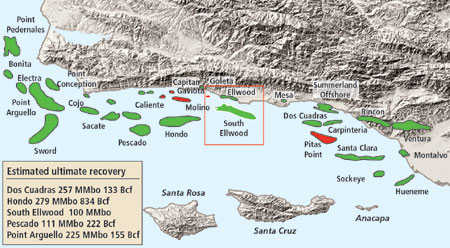 |
Fig. 1. South Ellwood is central among fields in the South Santa Barbara Channel.
|
|
REFINED GEOLOGICAL MODEL
Arco shot a first-generation, 3D seismic survey over the field in 1982. This was originally processed as a group of 2D lines, due to the limited computing power then available. Using modern algorithms, these data were reprocessed during 2000. It became clear that the once simple, anticlinal structure was broken up by faulting into numerous compartments, with potentially independent oil-water contacts.
Two additional pieces of data helped the operator to understand this complexity. First, high-quality dipmeter data were available for the more than 40 wells that penetrate the Monterey. Secondly, the Monterey stratigraphy is remarkably consistent across the field, enabling careful comparisons of well log data to indicate where missing and repeated sections might exist.
Putting this jigsaw puzzle of multiple, repeated sections together in 3D placed great demands on the geological modeling software. Fortunately, a new product, GoCad, proved to be up to the task, and a working static model has now been exported for reservoir simulation. A 3D view of the current model shows the degree of compartmentalization, Fig. 2.
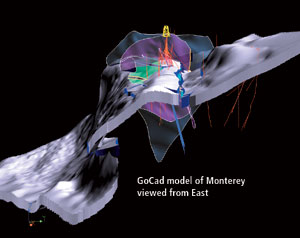 |
Fig. 2. The Monterey formation’s stratigraphy is consistent, showing a fair amount of compartmentalization.
|
|
DEVELOPMENT DRILLING
Venoco’s first well was drilled in May – June 2002 along the crest of the anticline toward the PRC3242 lease boundary. High-resolution image logs were run, and the well was completed in the heavily fractured Lower Monterey at the field’s oil-water contact.
Initial production test results were disappointing, with the well producing 1,700 bfpd with a 90% water cut. A production log showed that the oil-water contact was 100 ft higher than expected, and pressure build-up data suggested that the well was producing from a fault block, separate from the main field. The geological model indicated that a large thrust fault intersected the well in the Upper Monterey and was likely to be sealing.
The well was re-completed just underneath this fault in February 2003, and it initially tested at 812 bopd and 2 MMcfgd. Production data show that the new well presents no interference effects on the rest of the wells on the fault’s hanging wall side. The new well has produced more than 200,000 bbls of oil and paid out the $4-million drilling cost.
THROUGH-TUBING PLUGBACK PROGRAM
Conventional well logs have not succeeded in predicting the Monterey’s fluid content. Arco made extensive use of DSTs to select completion intervals. A more cost-effective approach became available, when Schlumberger developed a new generation of production logs. GHOST/ DEFT tools were run on seven key wells and thru-tubing, inflatable bridge plugs were run in five of them.
In total, the bridge plugs have shut off 2,000 bwpd, permitting Venoco to increase oil output from other wells. One well, 3242-18, experienced a 500-bopd increase that has been maintained for more than 18 months. Decline analysis suggests that this well’s estimated, ultimate recovery has increased 6 million bbl as a result of the plugback. The geological model indicates that the well’s lower section was completed in a fault block that had watered out. The other plugbacks did not increase oil production significantly, because they were re-completed within the same fault block. The production log and plot are shown in Figs. 3 and 4, respectively.
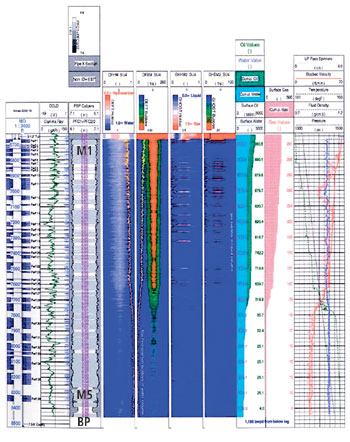 |
Fig. 3. A new generation of production logs has made it easier to predict the Monterey’s fluid content.
|
|
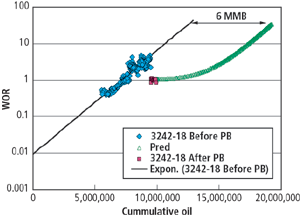 |
Fig. 4. The improvement in well 3242 – 18’s output is evident in this production plot.
|
|
FUTURE PLANS
Two undrained Monterey fault blocks were identified from the reprocessed 3D data: the North flank and the Eagle Canyon blocks. In addition, the 3D data permitted a new interpretation of the Sespe closure that extends the accumulation far to the west. The trajectories of the planned appraisal wells, two of which will be drilled during 2004, are shown in Fig. 5.
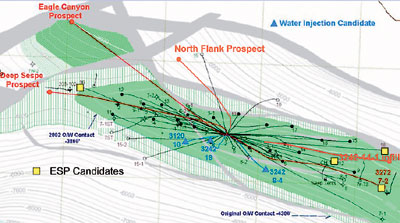 |
Fig. 5. Several attractive targets remain to be exploited by the operator at the South Ellwood field site.
|
|
The north flank fault block is perhaps the most attractive target, due to potential reserves of 30 million bbl and its relative proximity to Holly. The Sespe is also an attractive target, because it contains sweet, high-gravity oil. Depending on the results from the North flank well, the Eagle Canyon block may be drilled in 2005. 
THE AUTHORS
|
 |
Steve Horner graduated from Oxford University with a BA in physics, and from Stanford University in 1982 with an MS in petroleum engineering. He spent 18 years working for Occidental and Pennzoil in a series of international assignments before joining Venoco in 2000. He is presently the DOE project manager for South Ellwood.
|
 |
Marc Kamerling earned a BA degree in chemistry with specialization in earth science from the University of California, San Diego. He then pursued a master’s in geology at the University of California, Santa Barbara, graduating in 1982. After that, Mr. Kamerling joined Arco, working offshore southern California and in the San Joaquin basin. In 1993, he returned to UC-Santa Barbara, completing a PhD in 1994. He stayed on at the Institute for Crustal Studies, working on Southern California’s problems of structure, tectonics and earthquake hazards. He joined Venoco in 2002.
|
 |
Iraj Ershaghi earned a BS degree from the University of Tehran and a PhD in petroleum engineering from the University of Southern California. He joined the school’s Petroleum Engineering Dept. in 1972 and was nominated as the Omar B. Milligan Professor of Petroleum Engineering in 1995. Dr. Ershaghi is director of the West Coast PTTC and is a member of the New York Academy of Sciences.
|
|










